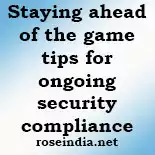Staying ahead of the game: tips for ongoing security compliance
Modern-day businesses collect and store different types of confidential data of customers and they are obligated to safeguard the confidential data they hold as compliance regulations, and laws require them to do so. Regulatory compliance refers to detailed instructions, rules, and requirements that are given by compliance laws to safeguard confidential data. Today, the compliance landscape varies in accordance with different data types, industries, and regions. Depending on these things a company can be obligated to be compliant with several international or local compliance regulations.
Not adhering to compliance regulations can bring severe consequences to companies. In every violation or data breach, compliance authorities can apply high amounts of fines and other penalties to companies. For example, if a United States-based healthcare company falls victim to a data breach, the Health Insurance Portability and Accountability Act (HIPAA) authorities can apply fines that can be as high as 1.5 million dollars yearly. In another example, if a company collects and stores any type of confidential data of EU-based citizens, and doesn't comply with General Data Protection Regulation (GDPR) requirements, then GDPR authorities can apply fines that can be as high as 40 million euros annually.
Shortly, adhering to compliance regulations and laws is critical for all sizes of companies. But, following compliance requirements isn’t sufficient to accomplish robust cybersecurity. In this article, we will give tips for establishing and maintaining security compliance. Let’s take a closer look at these security compliance tips.
1- Gather Cybersecurity Compliance Team
For ongoing security compliance, all sizes of organizations should have a cybersecurity compliance team that consists of compliance staff and IT professionals. This way, companies can align their cybersecurity efforts with compliance requirements, and create a good cybersecurity environment within the organization. Your cybersecurity compliance team will be responsible for creating a cybersecurity compliance plan and executing each step of the plan. Also, compliance is a continuously changing landscape, every once in a while regulators will obligate new rules and requirements to protect confidential data. For this reason, having a dedicated team is critical as the new rules, and requirements come into play, they can respond rapidly and maintain ongoing cybersecurity compliance.
2- Conduct Regular Internal Audits
Conducting regular internal audits is critical for ongoing cybersecurity compliance because, in every internal audit, companies can evaluate their security infrastructure and completely understand their current security strategy and its effectiveness. In these internal audits, you can find and pinpoint vulnerabilities, weaknesses, or outdated software that you are using. Understanding where you stand is really important because it shapes your upcoming cybersecurity efforts. In other words, once you understand your security infrastructure’s vulnerabilities you can rapidly respond and implement needed security policies, procedures, and measures to fix these vulnerabilities and mitigate potential cybersecurity risks.
3- Conduct Risk Analysis
Risk analysis is a critical part of cybersecurity compliance. Conducting risk analysis will help you identify the degree of risks for each dataset, information system, and asset. The risk analysis process consists of four steps and these are identification, assessment, analysis, and setting risk tolerance. The identification step refers to differentiating every information asset, information system, dataset, and the networks they use for access. The assessment step refers to setting the risk level for every data type and distinguishing high risks involving areas where critical information is located. The analysis step is for understanding the risk impact on the organization. The risk tolerance step is for classifying and prioritizing the risks.
By following these steps, you can understand which measures, security policies, and procedures should be taken. Also, you can intensify your security efforts for high-risk involving areas. Shortly, conducting regular risk analysis can help you achieve ongoing cybersecurity compliance.
4- Set Security Controls
Setting security controls is vital for ongoing cybersecurity compliance. To cope with cybersecurity risks, you need to implement the right security tools, measures, policies, and procedures that are aligned with compliance requirements. These security controls can be data encryption, network firewalls, identity access management (IAM), rigid password policies, incident response plan, employee education, and so on. Your cybersecurity compliance team can make a list of all required security tools and measures, then they can start implementing them.
Also, you should be careful while choosing vendors for security solutions. Purchasing security compliance solutions from well-known, reliable vendors is critical. On this matter, NordLayer’s solution on security compliance can be a great option as it is a well-known, reliable cybersecurity company that helps companies establish cybersecurity compliance. After implementing these required security solutions, your team should test your security infrastructure to completely understand if everything is functioning adequately or not. Testing will help you find functionality problems in your security infrastructure. According to these results, you can solve functionality problems and improve security.
5- Use Automated Tools
Our last tip is to advise companies to use intelligent and automated tools. Automation is really critical for ongoing cybersecurity compliance. Compliance requires a lot of time-consuming work like documentation and reporting. That’s why commonly companies see compliance as a daunting and challenging matter, but it doesn’t have to be. Using intelligent and automated tools can help you save time, and handle some parts of the manual work in the compliance operation, especially around workloads, documentation, and reports. While these tools cover a part of the manual work, your security compliance team can work on more important things and save time. Lastly, these tools can help you save a lot of money and reduce security compliance costs.
Last Remarks
Being compliant with regulations and laws is a necessity for all sizes of companies. But, complying with regulations doesn’t ensure the complete safety of confidential data as these requirements commonly consist of basic security measures, and policies. That’s why combining security and compliance is required and establishing cybersecurity compliance is vital for organizations. Many organizations consider cybersecurity compliance as a challenging matter, but it doesn’t necessarily have to be. Applying the security tips that are mentioned above can help companies establish security compliance.
John Rohith
John Rohith is technical author with more then 12 years
of experience in technical journalism. He is Science
Graduate with years of experience in many technical
writing. He is writing for many websites, news papers and technical magazine.
He is interested in research in latest Cyber Security technologies. Contact author at:
Email: [email protected]

